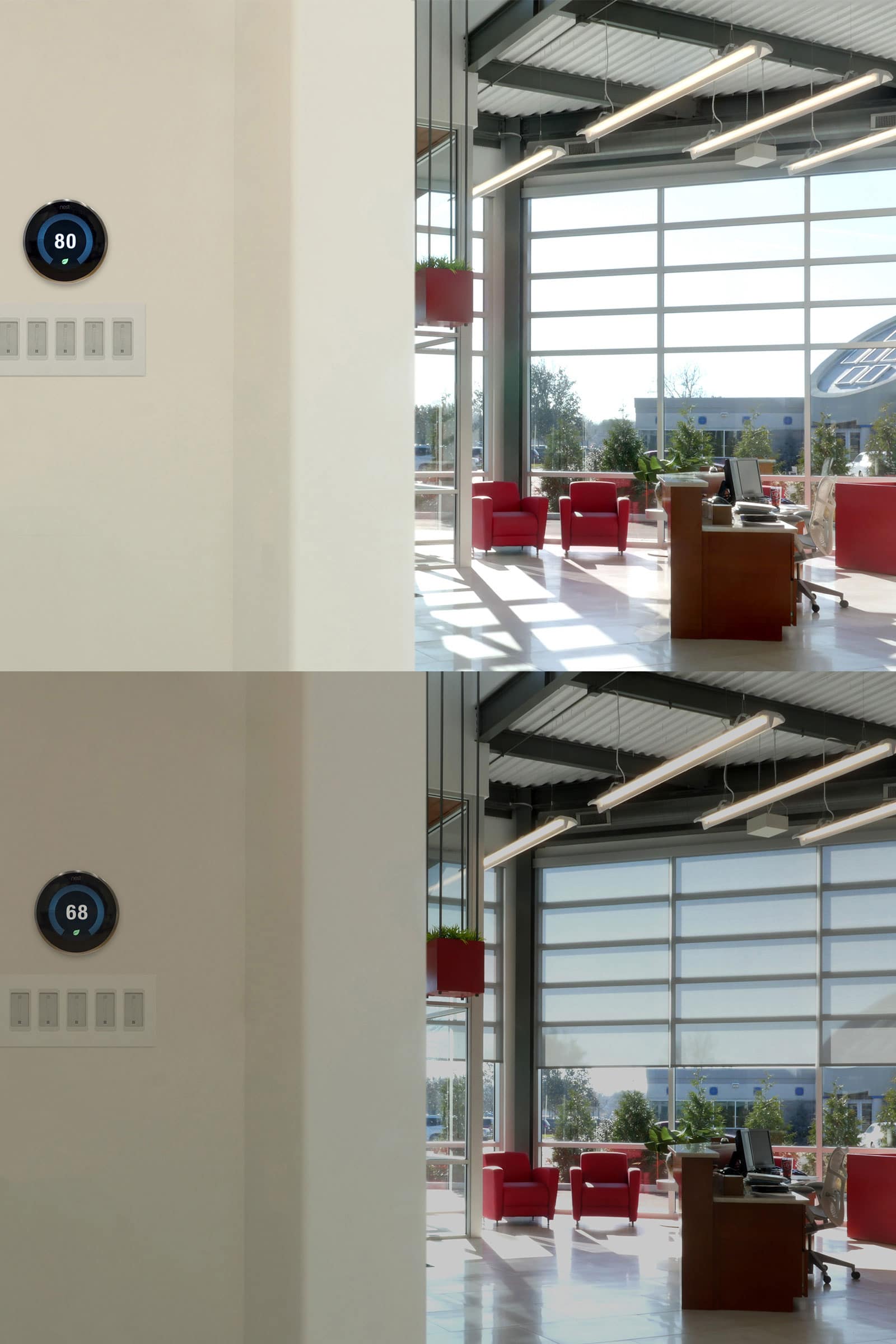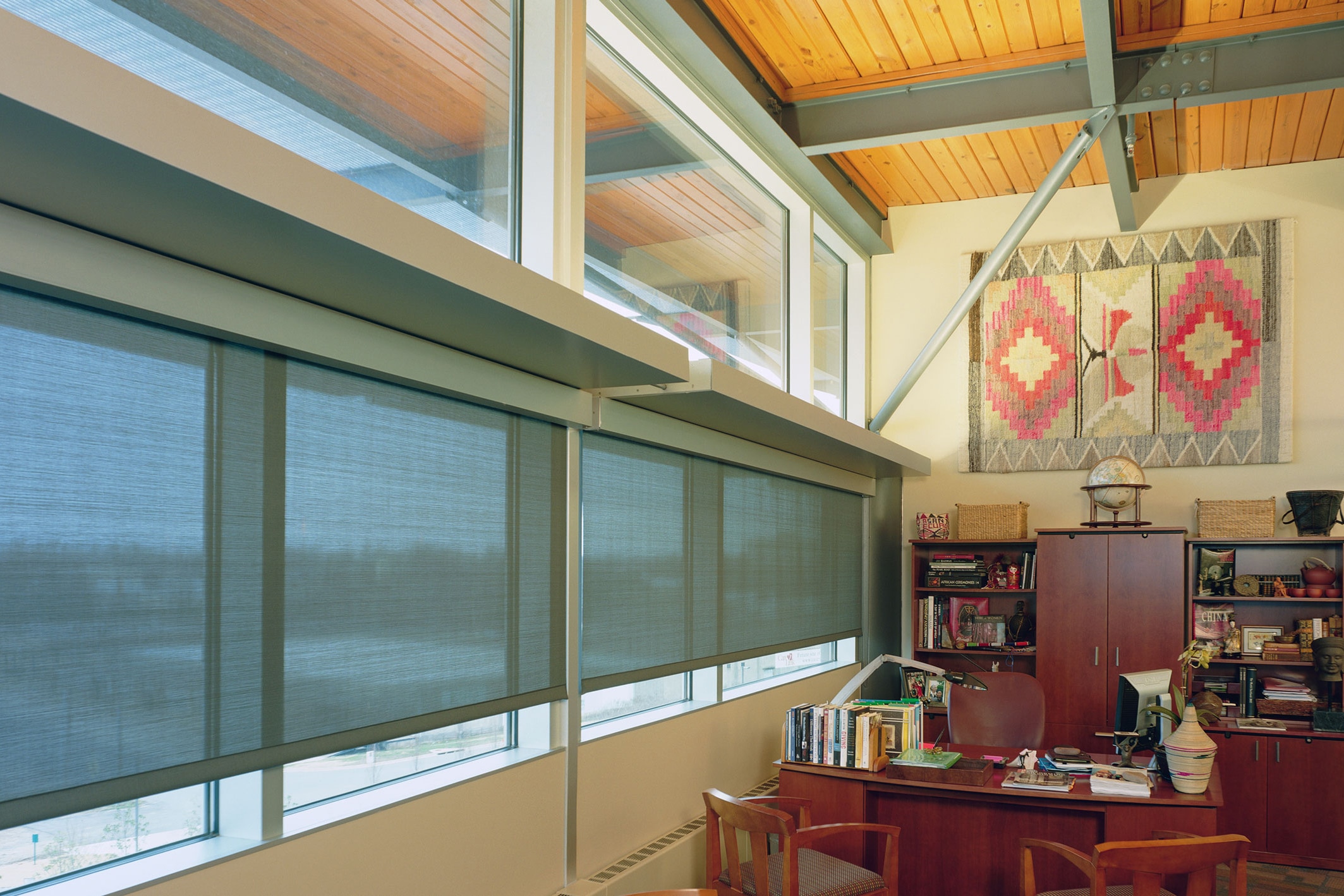Modern architecture relies more on windows than ever before. Daylighting advocates frequently cite increases in productivity to support the use of daylighting, views of the outside, and dimmable lighting in commercial construction.
Glazing advances in modern windows lower heat loss, cut air leakage, and minimize condensation. However, glare, solar heat gain, and direct sunlight still can diminish the comfort of interior spaces. This makes it more difficult to perform basic work functions and endangers occupant comfort.
That’s where a shading system comes in.
Visual and Thermal Discomfort Impact Performance
A study carried out by the California Energy Commission showed that the greater the glare potential from primary view windows, the greater the impact on office worker performance. All other things being equal, productivity decreased by 15 to 21%.
A joint study by the Helsinki University of Technology and Lawrence Berkley National Laboratory showed an average 2% decrease in productivity per degree Celsius when the temperature is above 25° C (77° F). Another study by University of Chicago researchers showed that productivity decreased by up to 4% per degree Celsius over 27° C (80° F). The WELL Building Standard states, “Leading research indicates employees perform 6 percent poorer when the office is overheated.”
But those are generalities. How do those percentages translate into the real world?

Using the right colors and openness factor mitigates the effect of direct sunlight on building occupants. Photo by Draper, Inc.
Productivity Gains Mean Big Savings
Let’s consider a commercial office space with a floor plate of 24,300 rentable square feet, yielding 20,000 usable square feet. We’ll allocate a high average of 175 square feet to each of 114 employees.
A conservative low average salary of $40,000 per employee with 40% burden (payroll taxes, benefits, etc.) gives us an annual labor cost of $6,348,000. That means every 1% gain in productivity equals $63,480 per year.
Using the 6%decrease in productivity quoted by the Well Building Standard, there is up to $383,040 available from increased productivity.
Using the 21% impact that the California Energy Commission says glare has on productivity, we find another $1,340,640 in productivity gains available.
That’s a total of over $1.7 million in productivity gains each year.
It’s reasonable to assert that a shading system can impact at least half of the productivity gain through glare control. So let’s work with a 10% increase in productivity as a result of the shading system.
For the assumed floor plate, we multiply the 10% productivity increase by $63,480, for a gain to the client of $634,800 annually thanks to the shading system. That’s a conservative estimate that doesn’t even include thermal comfort.

The fixed exterior device at Heifer International headquarters could not cope with glare from sunlight reflecting on water. Photo by Paul Barrows
Occupant Welfare: A Case Study
In 2006, Heifer International opened its new headquarters building in Little Rock, Arkansas. The building was designed with sustainability and natural light in mind. It included energy efficient plate glass windows for passive solar heat and indirect light and a curved shape to capture the maximum amount of sunlight. These and other sustainable construction practices helped the building achieve a LEED Platinum certification.
But when the facility opened, a glaring problem emerged—quite literally. Workers were unable to use their computer stations on the South side of the building due to the sun load coming through the extra-large windows. Although fixed exterior sunshades were in place to help with passive solar control, workers were getting additional glare from the water that surrounds part of the building.
The problem was resolved by adding interior roller shades with a 5% openness factor to still allow views through to the outside.
Sustainability Also Brings Value
A San Diego real estate market study found the vacancy rate for green buildings was 4% lower than for non-green properties (11.7%, compared to 15.7%). The report also noted that LEED-certified buildings often brought in the highest rents.
According to Lux Research, LEED Gold buildings significantly outperform other buildings. For example, LEED Gold certification of a model 80,000 square foot commercial building in Los Angeles resulted in $4.1 million higher rental income.

Interior shades had to be added to the Heifer International building to allow building occupants to work in comfort. Photo by Timothy Hursley
What Kind of Shading System Do I Need?
There are several options when planning a shading system.
Fixed exterior shading devices
These systems cannot react to changing sky or sun conditions and are extremely expensive to be effective, and, practically speaking, can only be effective on south elevations (in this hemisphere). Fixed exterior shading devices are frequently designed to reduce solar heat gain and will generally require interior shading to reduce glare and provide occupancy comfort.
Dynamic glass (electrochromic glass)
This is becoming more prevalent as the technology becomes more marketable. However, it is still extremely expensive, issues with color uniformity can affect the exterior appearance of the building, and it is generally not suitable for existing buildings.
One-inch mini blinds
These need to be closed or tilted to 45 degrees to be effective for solar and glare control, requiring frequent adjustments. Occupants lose their view to the exterior. One-inch mini blinds are high-maintenance, requiring frequent cleanings to eliminate airborne dust and potential pathogens. Frequent adjustment increases damage; this requires extensive attic stock, forcing building management to store excessive material, especially in multi-tenant buildings.
Solar shades
Shades are designed to be flexible. They are only there when you need them–just roll them up and out of the way. You can match fabric openness to orientation and colors to reduce and control glare. With the correct combination of color and openness factor, you can also maintain a view through to the outside while reducing glare and solar heat gain. Roller shades are extremely durable, frequently outlasting multiple tenant lease periods.
Shade Cost Versus Overall Budget
The budget for a typical moderate open office space is $183 per square foot, according to Jones Lang LaSalle research data, which does not include furniture and data infrastructure. For the 24,300 square foot space used above, that means an overall budget of $4,392,000.
Perimeter details impact shade budgets. For example, mounting shades inside or between the window mullions can be done with or without a fascia to conceal the shade roller and hardware. For manual shades without fascia, this detail will cost $1.53 per rentable square foot. With fascia it is $1.70. Mounting the shades above the ceiling in a pocket is $1.58: only 0.862% of the budget.

Shades provide maximum comfort for building occupants. Motorization and automation increase the benefits of solar shades. Photo by Brett Drury
Motorized Shades Add Value
Although some see shade motorization as a luxury upgrade, it is an important tool to increase the efficiency of the shading system and its impact on building performance. Motorized shades also a relatively small upgrade.
Using the same example as above—shades mounted above the ceiling in a pocket—basic motorization would be $2.97 per square foot. That’s only 1.625%of the budget. (This budget information does not include the cost of the ceiling pocket or electrical.)
For this relatively minor increase in cost, motorized shades help you to:
- Maximize energy efficiency.
- Maximize occupant comfort.
- Remove the human element by allowing the shades to respond to existing light conditions.
- Allow for override switching in specific areas for local control when required.
- Program “scenes,” timed events, or seasonal performance.
- Achieve a consistent exterior appearance.
- Integrate with lighting control systems.
Given all these advantages, while adding less than 2% to the overall project budget, the case to include motorized roller shades on a project is pretty convincing. This case moves from convincing to compelling when using the previous 24,300 square foot example and realizing that the overall cost of adding motorized shades can be recuperated within the first two months of building operation based solely on increased occupant performance. Taking all of this into consideration, the question becomes less about why use motorized shades and more about why not.
Don’t Be Afraid of Automation
Transitioning from motorization to automation can sound scary and complicated but it really isn’t. Simply add sensors or scheduled control, and you have a basic form of automation. You can also add solar tracking and automated glare control. The shading system can be completely autonomous or fully integrated with a building management system (BMS) and/or lighting controls.
Adding automation helps you maximize the benefits of daylight harvesting, mitigating glare and heat gain in the workspace while allowing natural light into the building.
Automated shading systems are part of the effort to meet ANSI/ASHRAE Standard 55: Thermal Environmental Conditions for Human Occupancy. This standard establishes the ranges of indoor environmental conditions to achieve acceptable thermal comfort for occupants of buildings.
Although market perceptions exist that shade automation is expensive, the reality is drastically different—a design professional can effectively automate floor, by elevation, or per tenant for a very small premium. At one time, the cost for automation could be as much as four times the cost of the shades themselves; today automation is now a fraction of the cost of shades. A seismic shift in technology, simplification, and reduction in the cost of components all combine to place automation within reach of most buildings.


